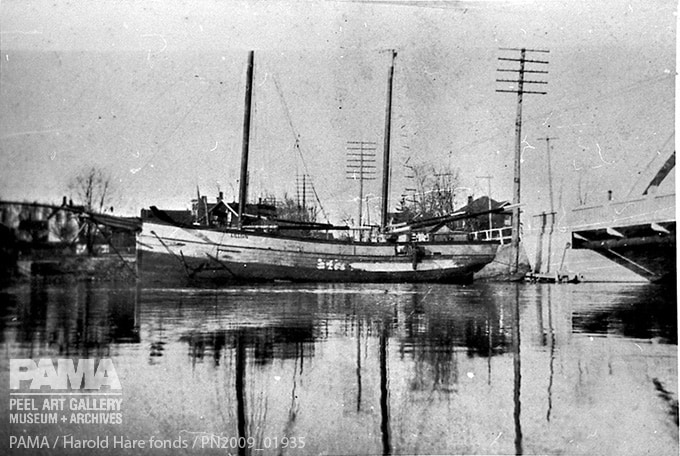Mississauga History: Past Industries
Published September 23, 2013 at 1:24 pm

Wherever in Mississauga you live, unless your house is historic, it was previously a farm. But as big as agriculture was, many other industries flourished in “Toronto Township” and the “Town of Mississauga”.
Here are five companies or industries of note in the worlds of food additives, oil, construction material, transportation, and recreation.

Do you remember this bottle in your fridge? In another era, Bee Hive Corn Syrup was one of Canada’s most popular brands. The company set up a “corn wet milling factory” factory at the foot of Centre Road in 1889, in Port Credit, beginning to produce corn starch the next year. It was an ideal location: both near the Grand Trunk Railway line and the harbour, partway between the hubs of Toronto and Hamilton.
Centre is now Hurontario Street, and the company moved out in 1990. Little remains of the large industrial lot, namely the St. Lawrence Starch Limited Administrative Building, built in 1932.
The photo shown is actually believed to be from the 1980s, despite the vintage truck. The tin, included in the PAMA museum’s permanent collection, is believed to date back to 1897, as the side of the package commemorates Queen Victoria’s Diamond Jubilee.

When you think oil refineries, what comes to mind? Giant platforms offshore in the Gulf of Mexico? The Middle East? Fort McMurray, Alberta? Did anyone think of Mississauga?
Suncor Energy opened to supply oil for Allied bombers in World War II. It has operated under various owners since 1943, and continues to process many thousands of barrels a day. They’ve diversified recently, and produce 350 types of lubricant, apparently ranging from baby oil to the coating on gummy bears.

Port Credit was a top spot for stone hookers. The shale deposits on the bottom of Lake Ontario were prime building material, and stone hooker boats would hook onto the shale, and dredge it up.
Seen here is the two-masted schooner Lillian being painted, prior to its sale in 1928. Originally built in 1859 in Henderson, New York, this fifty foot schooner spent part of its working life carrying cargo between Oswego, New York and Prince Edward County. Brought to Port Credit in the late 1870s, it was then used for stone hooking. By the 1920s the owner had added an engine driven propeller.

With the popularity of the Malton International Airport and a World War II Allied Flying Training Programme in the area, Malton became a hub for all sorts of aviation businesses. Throughout the 1950s and 1960s, the aviation industry grew. The Jetliner, North America’s first passenger jet, was built in Malton, and the cancelled AVRO Arrow fighter jet was developed locally. Even with the crushing cancellation of the Arrow by Prime Minister John Diefenbaker, the industry still existed. In a 1967 Town of Mississauga Planning Board report, Orenda Engines and de Havilland Aircraft are listed as the two largest firms in town.
Finally, bowling pins. Brunswick-Balke-Collender built a factory on Dundas Street, on an old farm near the community of Dixie. Brunswick is an important name in the bowling world: they own bowling alleys, create bowling products for consumers like bowling balls and bags, and produce products for bowling alleys (the parent company invented the automatic scorer in 1970). Part of the factory originally built pleasure boats for a sister company, Mercury Marine, and another area included a bowling centre for employees.
Brunswick used to operate a bowling alley on Stanfield Road, and their distribution centre moved in recent years from a location in west Mississauga, just over the border into Halton.
INsauga's Editorial Standards and Policies









